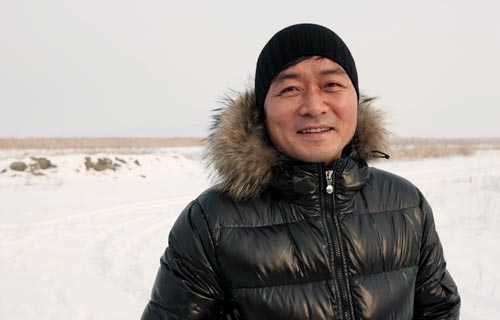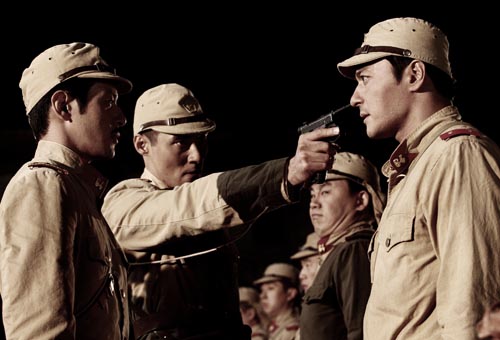In his new film, ‘Taegukgi’ director returns to pain of war

Kang Je-kyu, the legendary director of “Taegukgi: Brotherhood of War” (2004), prepares for another war blockbuster, “My Way,” in Saemangeum, North Jeolla. [JoongAng Ilbo]
Filmmaker Kang Je-gyu has only directed three films in the past 15 years - “The Gingko Bed” (1996), “Shiri” (1998) and “Taegukgi: The Brotherhood of War” (2004) - but each one has changed the landscape of Korean film.
“The Gingko Bed” was the first Korean romance movie to make use of computer graphics and it earned Kang critical acclaim. And it’s hard to discuss the renaissance of Korean film without mentioning Kang’s second spy film “Shiri.” More than a decade has passed since the release of “Shiri,” but the film is still the eighth-highest grossing Korean film ever. His third film “Taegukgi” was the first Korean war blockbuster and the third-highest grossing Korean film, according to the Korean Film Council.
Now, Kang is working on a new film called “My Way,” which is slated for a December release. At a cost of 30 billion won ($27.2 million), it has the highest production budget of any Korean film in history.
Like “Taegukgi,” the film is also about war and has Jang Dong-gun as its star. But that’s where the similarities end.
“My Way” is based on a true story that follows the tumultuous life of a man who is conscripted into Japan’s Kwantung Army and is forced to fight for three countries - Japan, China and Germany - during World War II.
The JoongAng Ilbo got the chance to interview Kang over the phone. Here are some excerpts from that interview.

A scene from “My Way.” The war film features Korean actor Jang Dong-gun, right, and other pan-Asian actors, including Japanese actor Joe Odagiri, left. Provided by Directors Film Company
Q. What prompted you to direct “My Way”?
A. When I first read through the screenplay, I didn’t have any intention of directing the film but I happened to see a documentary on SBS about a Korean man who was forced to join the Kwantung Army and had to wear the military uniforms of three countries - Japan, China and Germany - and ended up being captured by the United States in the Invasion of Normandy. It was intense. It made my blood boil. That was the moment when I decided to direct this film.
What most attracted you to the story?
An ordinary man is thrown against his will into a tumultuous period of history and it seems like he would be overwhelmed - but he survives. I really wanted to investigate what saved him from his painful personal history, things like his dreams and his strong instinct to survive.
It must have been difficult to do another war film.
After “Taegukgi,” I swore that I wouldn’t do another war film because it’s so difficult to shoot. The weather is always a factor and it involves many risky elements. Because we had a lot of snow and rain last month, we had to postpone production a couple of times. We’ve already spent much more time shooting than when we did “Taegukgi,” and that took nearly three times as long as ordinary commercial films. And because this is about history, we have to be careful not to distort the facts.
Despite those difficulties, what made you decide to do another war film?
I think the most inhuman and vicious thing created by humans is war. Humans keep engaging in wars but it’s a good-for-nothing game. I hope my film will change people’s mindset about war.
Most young people don’t know that much about war.
For them, war is probably like a video game or martial arts. They accept war easily and indifferently. What will happen when these young people grow up and become this nation’s leaders? I’m really concerned.
Do you think that films about war could function as good material for history education?
Films have diverse functions, and some films enlighten and educate people. As a director, I have to create a story that blends meaning and entertainment.
Let’s say there is a young boy who is dragged off to a movie theater by his father. The boy doesn’t want to watch the film because he thinks it’s boring but in the end he enjoys it much more than his father does. Every director has to think about how to make a film that will appeal to a variety of people.
The production cost is astronomical. Wasn’t that burdensome?
To be honest, phrases like “highest-ever production cost” are burdensome. But think about this: Chinese director John Woo had a budget of 80 billion won for “Red Cliff” (2008) but critics and Chinese audiences didn’t judge the film based on the cost.
After “Taegukgi,” you signed a contract with Creative Artists Agency, which also represents famed directors like Oliver Stone and Steven Spielberg, and you’ve been trying to make films in Hollywood but with no finished products. What makes you want to work in Hollywood?
Some films are quintessentially American, like “Batman,” which I think can only be made by American directors. But I didn’t go to Hollywood to make those kinds of films.
As an Asian filmmaker, I wanted to tell stories that involve both the East and the West. I want to produce films that will shed light on Asia and introduce Asia to the West, and I think “My Way” is a step in that direction.
Does that mean that you’re hoping to reach a wider, more global audience with your films?
It’s every director’s dream to communicate with more people through their films, regardless of their nationality. If “My Way” succeeds, I think it will change people’s perception of Asian and Korean movies.
By Ki Sun-min [so@joongang.co.kr]
Related Korean Article [중앙일보]
2011 문화 파워 ③ 300억짜리 전쟁영화 ‘마이 웨이’ 찍는 강제규 감독
스토리 처음 만났을 때 피가 끓었다
한·일 젊은이들의 가슴을 열겠다
새해, 충무로에서 가장 원대한 꿈을 품은 사람 중 하나는 ‘태극기 휘날리며’의 강제규(49) 감독일 것이다. 그가 신작 ‘마이 웨이’로 7년 만에 돌아온다. ‘마이 웨이’는 2004년 1174만여 관객을 동원하며 역대 흥행순위 3위에 오른 ‘태극기 휘날리며’와 여러모로 닮았다. 일단 전쟁블록버스터라는 외양이 같고 주연배우도 장동건 그대로다.
전쟁의 야만성과 그로 인한 인간성 상실을 짚고 넘어가는 점은 물론이다. 달라진 건 시대배경과 스케일이다. ‘태극기 휘날리며’는 한국전쟁으로 인한 형제의 비극을 그렸다. ‘마이 웨이’는 제2차 세계대전 당시 관동군에 징집돼 일본·중국·독일 3국의 군복을 차례로 갈아입어야 했던 조선인 청년의 운명을 다룬다. 나아가 일본인 청년과의 세월과 국적을 뛰어넘은 우정을 통해 한·일 간의 진정한 소통과 화해라는 만만치 않은 주제까지 건드릴 계획이다.
제작비는 261억원. 마케팅비 등이 포함된 총제작비로 따지면 300억원대다. 한국영화 사상 최고 제작비다. 장동건과 오다기리 죠라는 아시아권 스타 캐스팅, 한·중·일 3개국 동시개봉 추진 등으로 손익분기점을 훌쩍 뛰어넘으려는 야심 찬 프로젝트다. 국내에선 CJ엔터테인먼트와 SK텔레콤이 투자했다. 다국적 프로젝트 성공사례가 거의 없었던 충무로에서 ‘마이 웨이’의 성공 여부는 뜨거운 관심사다. 지난해 10월부터 전북 새만금에서 촬영 중인 그를 3일 밤 전화 인터뷰했다. ‘마이 웨이’는 12월 개봉 예정이다.
-‘마이 웨이’를 하게 된 이유는.
“3년 전쯤인가 할리우드 워너브라더스 본사에서 김병인 작가가 쓴 시나리오 초고를 보여줬다. 그 후 SBS에서 방영된 다큐멘터리(‘노르망디의 코리안’)를 봤다. 조선인으로 태어나 강제 징집돼 일본·중국·독일 세 나라의 군복을 갈아입은 끝에 노르망디 해전에서 미군 포로가 된 남자의 실화였다. 강렬했다. 심장이 뛰고 피가 끓는 느낌이었다. …
http://article.joins.com/news/article/article.asp?total_id=4884667










with the Korea JoongAng Daily
To write comments, please log in to one of the accounts.
Standards Board Policy (0/250자)